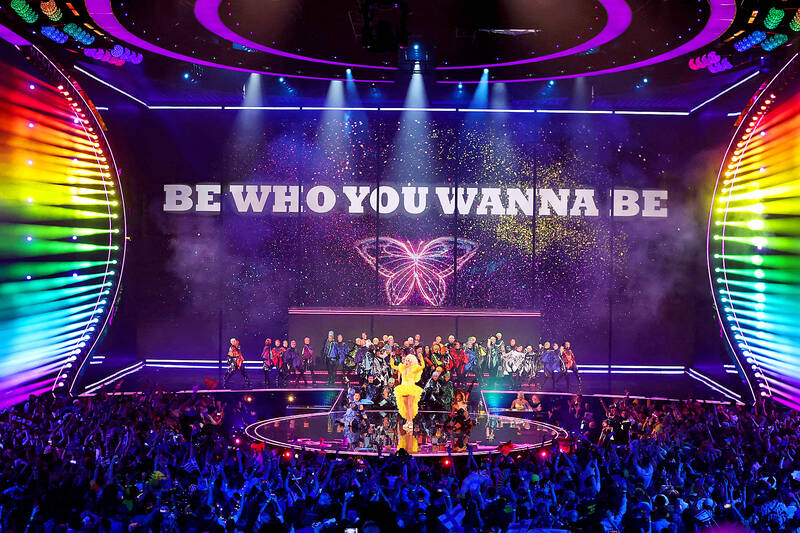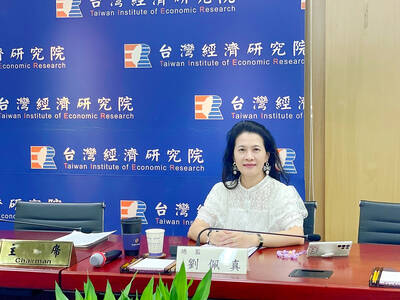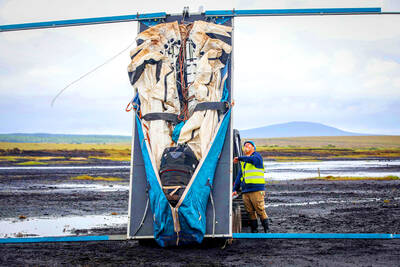Often called the campest competition in the world, the Eurovision Song Contest came to Liverpool this week, with tens of thousands of LGBTQ+ fans descending on the northern English city to spend big and play late.
Liverpool — which gave the world The Beatles — has embraced the kitsch annual show with zeal and its Pride Quarter, with more than 10 LGBTQ+ bars and clubs, expects a big boost from a slew of international visitors who identify as LGBTQ+.
“Since Liverpool was announced [as host city], I’ve talked about it every time I DJ,” said Shaun McKenna, a drag performer and DJ who works at one of the city’s oldest gay bars.

Photo: Reuters
“I get everyone screaming for it. About 50,000 people come for Liverpool Pride and that’s only one day [so this is] fantastic,” he said.
McKenna was spending most of the run-up to yesterday’s grand final as his alter ego Lady Sian, a stalwart of the ever-popular Bar Lisbon.
“Eurovision is the campest thing in the world,” 58-year-old McKenna said from behind the ornate venue’s bar, kitted out with large screens for a jam-packed schedule of Eurovision-themed events.

Photo: Reuters
Liverpool was chosen to stage this year’s contest — with competitors from 37 nations — on behalf of last year’s winner Ukraine, whose war with Russia precluded it from hosting.
With Liverpool’s council vowing to make this year’s event the most inclusive yet, LGBTQ+ venues in the former industrial dockland city are already experiencing a boost in takings.
“We’ve had fans coming in from April. We had a Ukrainian girl who asked us to play a song from her hometown,” McKenna said. “She gave me a £10 [US$12.50] tip.”
Liverpool was expecting 100,000 visitors for Eurovision, about double the crowd that hit Turin, Italy, for last year’s final.
Tickets to the live shows cost fans up to £380, while the price of staying over for the final last night has increased by as much as 300 percent in some hotels.
It came as Liverpool limps back from the COVID-19 pandemic, with income from inbound visitors crashing by 79 percent in 2020 as the country locked down and stayed home.
Like other tourist hubs across Britain, the city is struggling with slow growth and runaway inflation, making any boost to the hospitality industry welcome.
“During the pandemic, Liverpool’s visitor economy shrank until near nonexistence. The noticeable element, the idea of coming together to celebrate, that was lost,” said Jan Brown, a senior lecturer from Liverpool John Moores University.
“The opportunity to re-imagine the city as welcoming to all is huge,” she said.
Eurovision began in 1956 in a bid to unite Europe after World War II. For many LGBTQ+ fans, the contest has since become synonymous with an exuberant — and often camp — show of self-expression, gaining a global following.
Contestants have proved diverse, too.
In 1961, Luxembourg’s Jean-Claude Pascal won the contest with a song interpreted by many fans as a same-sex love song.
Dana International became the first openly LGBTQ+ and transgender winner, singing for Israel in 1998.
Conchita Wurst, the drag persona of singer Thomas Neuwirth, became the first openly gay winner for Austria in 2014.
“Eurovision has always been popular among the queer community — it just didn’t come out until the 1990s,” said Dean Vuletic, an academic expert on Eurovision.
Vuletic said that the introduction of public voting and a new, commercial exploitation of the contest took its LGBTQ+ fan base out of the closet and onto prime-time screens, with 161 million viewers watching the final last year.
“That’s when you started to notice gay fans on television,” he said from Liverpool.
“Eurovision has really come to value its gay following — the visibility of the rainbow community is one of the things that makes it so special and diversity has become part of its brand,” he said.
Staging Eurovision can cost a host city £8.5 million to £21 million.
The Liverpool City Council said by e-mail that it expects the contest to generate extra local spending of up to £25 million right off, with another £250 million projected in the coming years.
Analysts predict the immediate gains could be even higher, with NatWest Group PLC estimating that fans would spend more than £40 million in the city over a jam-packed week of events, given the city’s assiduous courtship of LGBTQ+ visitors.
Liverpool Pride, which draws about 50,000 visitors each summer, brings in about £5 million, according to the last data recorded before the pandemic in 2019.
In 2011, Liverpool became the first city in Britain to recognize its gay scene officially, adding rainbows to the area’s street signs, before it was rebranded as the Pride Quarter in 2021.
Almost all bars in the central Stanley Street area host drag queens — nightly — with three performers saying their work had more than doubled during Eurovision.
“The contest is going through another metamorphosis — the way it is being spoken about it, it’s no longer a joke,” said Bren O’Callaghan of Culture Liverpool, which was overseeing two weeks of events, including three days set aside for LGBTQ+ performers.
“In terms of our preparation, we’re talking about millions being spent,” he said.
Fans say they plan to let rip money-wise.
Alisa Lozova, who is Latvian and Irish, came to Liverpool from Dublin to fulfill a lifelong passion.
“Eurovision is sort of my obsession,” 22-year-old Lozova said outside Masquerade Bar, as it played Eurovision hits.
“Because it’s something so major that I’ve wanted to tick off my bucket list forever, I really don’t care how much spend. I would throw money to these people freely,” Lozova said.
Masquerade, which calls itself “Liverpool’s friendliest gay bar,” extended its hours and upped its capacity to cater for the influx of out-of-towners.
“It has been packed out, bigger than we thought it would be,” the bar’s general manager Gethin Mullock said.
“Saturday is usually our best night and this has basically been a row of Saturdays,” he said.

A proposed 100 percent tariff on chip imports announced by US President Donald Trump could shift more of Taiwan’s semiconductor production overseas, a Taiwan Institute of Economic Research (TIER) researcher said yesterday. Trump’s tariff policy will accelerate the global semiconductor industry’s pace to establish roots in the US, leading to higher supply chain costs and ultimately raising prices of consumer electronics and creating uncertainty for future market demand, Arisa Liu (劉佩真) at the institute’s Taiwan Industry Economics Database said in a telephone interview. Trump’s move signals his intention to "restore the glory of the US semiconductor industry," Liu noted, saying that

On Ireland’s blustery western seaboard, researchers are gleefully flying giant kites — not for fun, but in the hope of generating renewable electricity and sparking a “revolution” in wind energy. “We use a kite to capture the wind and a generator at the bottom of it that captures the power,” said Padraic Doherty of Kitepower, the Dutch firm behind the venture. At its test site in operation since September 2023 near the small town of Bangor Erris, the team transports the vast 60-square-meter kite from a hangar across the lunar-like bogland to a generator. The kite is then attached by a

Foxconn Technology Co (鴻準精密), a metal casing supplier owned by Hon Hai Precision Industry Co (鴻海精密), yesterday announced plans to invest US$1 billion in the US over the next decade as part of its business transformation strategy. The Apple Inc supplier said in a statement that its board approved the investment on Thursday, as part of a transformation strategy focused on precision mold development, smart manufacturing, robotics and advanced automation. The strategy would have a strong emphasis on artificial intelligence (AI), the company added. The company said it aims to build a flexible, intelligent production ecosystem to boost competitiveness and sustainability. Foxconn

Leading Taiwanese bicycle brands Giant Manufacturing Co (巨大機械) and Merida Industry Co (美利達工業) on Sunday said that they have adopted measures to mitigate the impact of the tariff policies of US President Donald Trump’s administration. The US announced at the beginning of this month that it would impose a 20 percent tariff on imported goods made in Taiwan, effective on Thursday last week. The tariff would be added to other pre-existing most-favored-nation duties and industry-specific trade remedy levy, which would bring the overall tariff on Taiwan-made bicycles to between 25.5 percent and 31 percent. However, Giant did not seem too perturbed by the